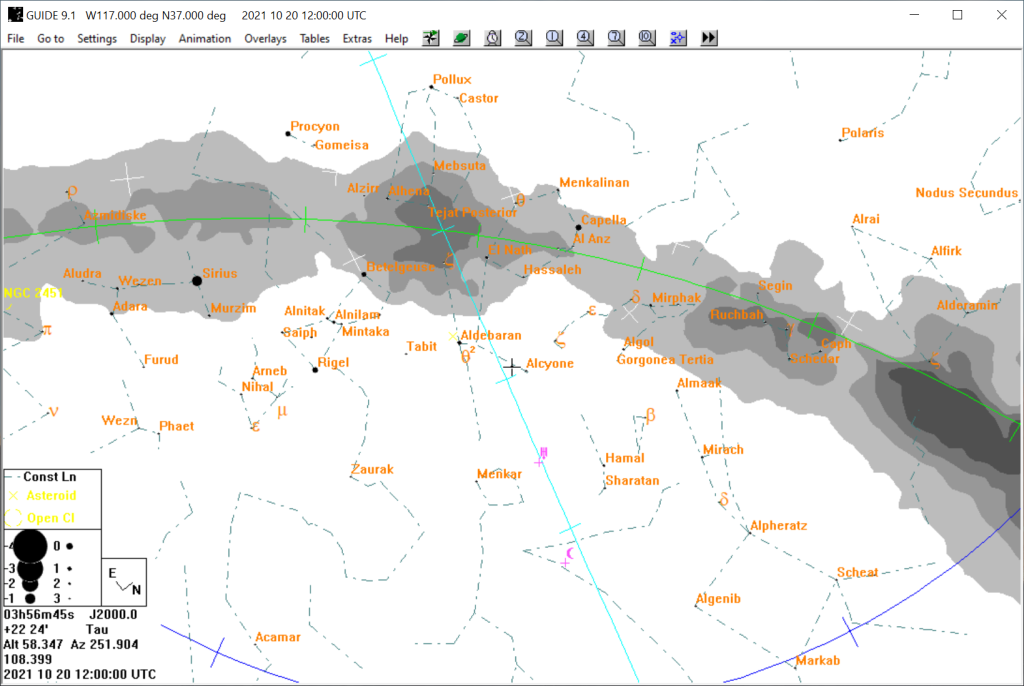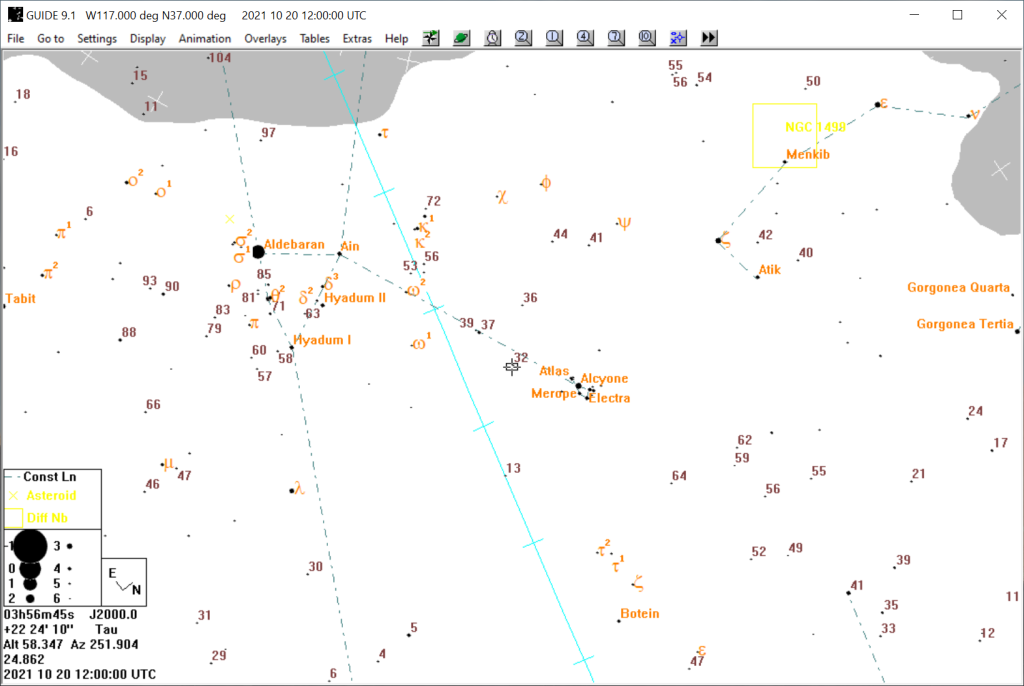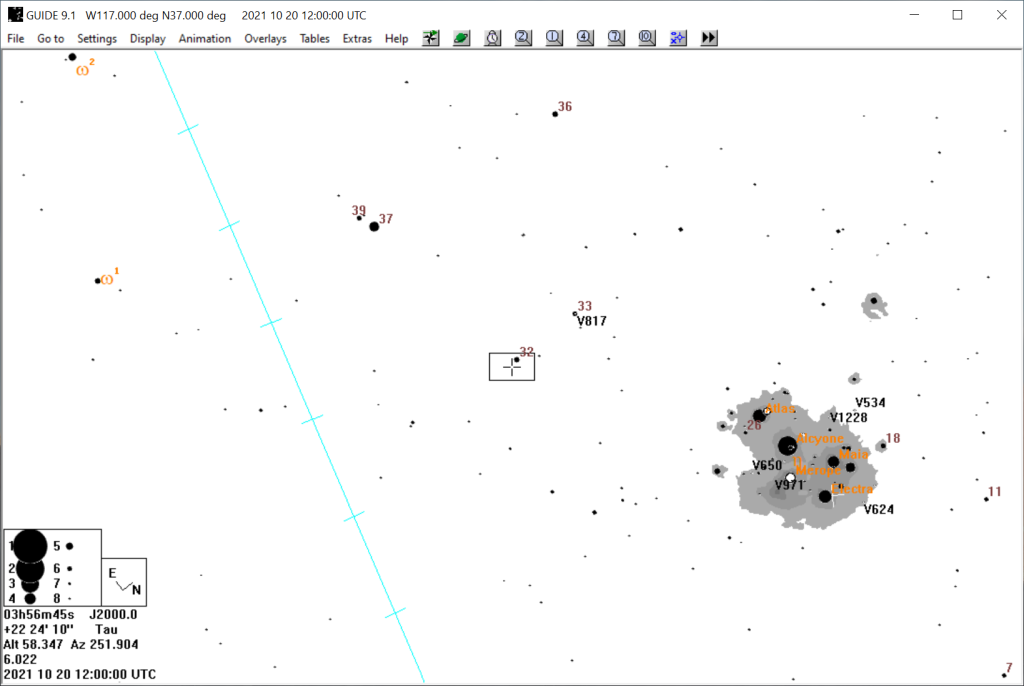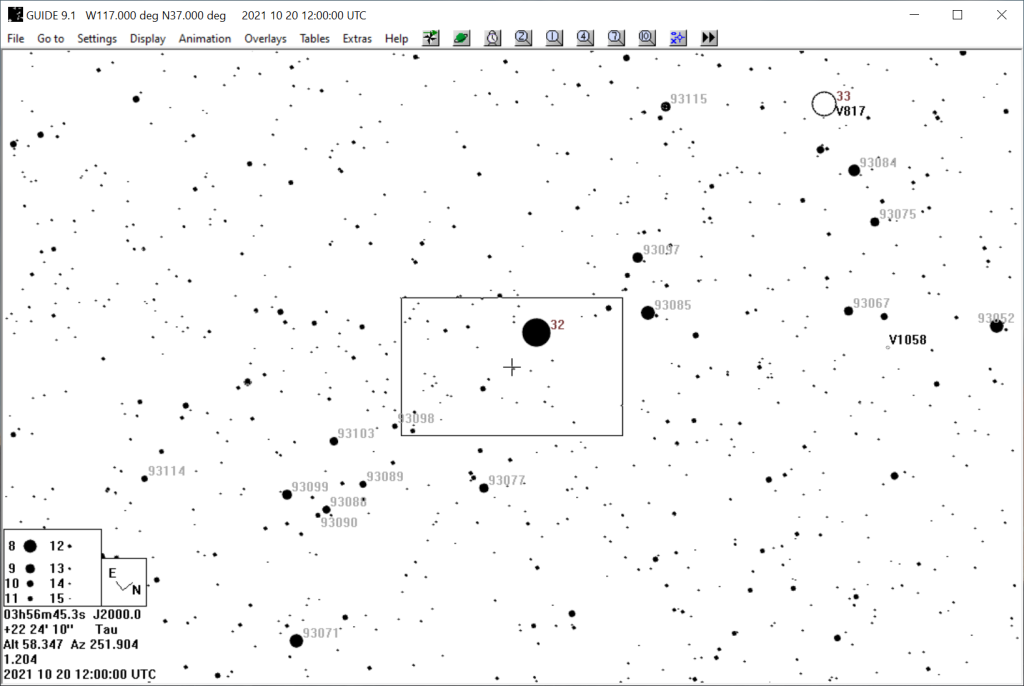This event involves the Jupiter Trojan (3548) Eurybates, one of the Lucy Mission flyby targets. This is a mobile campaign, deploying to the region just north of Las Vegas. We are not expecting any team to observe that has not already signed up to participate. The observations are to be done from a very localized region. This page summarizes the event-specific details about the observation but does not cover any of the logistics.
Event Details
Eurybates is expected to be slightly ellipsoidal in shape and 66 km in diameter. Eurybates also has a small moon, Queta, that is a few km in diameter. The position of the moon is still very uncertain but even so is not expected to be in our deployment region. New observations are expected from the Hubble Space Telescope in November but that will be too late to help us target that body. However, due to the orbit of Queta even now, once we get a good size for Eurybates we will also be able to determine an accurate bulk density for Eurybates.
There is still a slight chance that there is yet another moon around Eurybates. If so, it would be fairly large and quite close to Eurybates. If it exists we are not likely to directly see it. Instead, the indication of its existence will manifest as a shift in the position of Eurybates relative to the prediction. The prediction for the shadow assumes no such moon exists. However, the spread of our stations has been designed to capture this shift if it exists. Every station in the deployment plan is important for the scientific result from this campaign. The prediction can be seen in this map.
The event will be in the late pre-dawn hours of the morning of October 20. The useful deployment area will be west of the AZ-NM border. At the time of the event, there will be a full moon just 37 degrees away. Also, Eurybates will be visible while the star is occulted. It is 16x fainter than the star, it will be very faint in the fast occultation data. In the hours before the event, an exposure of a few seconds will be sufficient to show Eurybates before it merges with the star. There is no standard Event Detail Page for this event, but key observation details are provided below.
Pre-Event Checklist
- Make sure to charge your laptop and battery pack fully. Verify that systems are charged. This is easy for the laptop but sometimes the battery packs can be confusing and aren’t really charged when you think they are.
- Print this page or have it available by some electronic means that does not require a data connection. Many sites are remote and may not have cell phone coverage.
- Make sure your laptop is in airplane mode during data collection.
Observation Protocol
The of-date coordinates for the star are 03:58:02.7 +22:27:53, or 3.967417 +22.464722 (for the RECON CPC1100’s). The J2000 position is 03:56:45.3 +22:24:10 (3.945917 +22.402778). The event mid-time for the RECON teams is 12:00:00 UT. Take data from 11:57:00 to 12:03:00 UT. Use an exposure time of 200 ms for the QHY174 camera. Central events should last about 6 seconds. The easiest way to get ready for the event is to load the OCC profile and then change the exposure time to 200 ms.
The star training set for RECON systems is:
Star training set for EU20211020, (2021/10/20 12:00UT) Object RA Dec RA (decimal) Dec mag sep mel Aldebaran 04:37:10.5 +16:33:05 4.619583 +16.551389 0.8 10.95 44 44Zet Per 03:55:30.5 +31:56:48 3.925139 +31.946667 2.8 9.50 40 32 Tau 03:58:09.6 +22:32:21 3.969333 +22.539167 5.6 0.08 36 33 Tau 03:58:21.6 +23:14:14 3.972667 +23.237222 6.0 0.78 36 EU20211020 03:58:02.7 +22:27:53 3.967417 +22.464722 13.5 36 Positions are for equinox of date
The training set for other systems is:
Star training set for EU20211020, (2021/10/20 12:00UT) Object RA Dec RA (decimal) Dec mag sep mel Aldebaran 04:35:55.3 +16:30:29 4.598694 +16.508056 0.8 10.95 44 44Zet Per 03:54:07.9 +31:53:01 3.902194 +31.883611 2.8 9.50 40 32 Tau 03:56:52.2 +22:28:38 3.947833 +22.477222 5.6 0.08 36 33 Tau 03:57:03.9 +23:10:32 3.951083 +23.175556 6.0 0.78 36 EU20211020 03:56:45.3 +22:24:10 3.945917 +22.402778 13.5 36 Positions are for J2000
Make sure to log your observations (any data that are saved) either on a RECON logsheet (to be scanned later) or on an electronic file. Details about operating the camera and saving data can be found in the guide. Here are some reminders about the logsheet contents:
- Use one entry per dataset (series of images) collected.
- Use the UT time (HH_MM_SS) as shown on the green banner on the top of the screen at the end of the capture as the label in the left-most column on the logsheet. Don’t use an approximate time from some other means. This is used for finding the files, not documenting the time. If you miss the banner, you can browse the disk to find the folder that was written.
- Make sure to write down the observing location (lat/lon/alt) of your site on the logsheet. It is best to use a cell phone GPS app, not the SharpCap information for this position as a backup for the position.
- The telescope name is the community name for that telescope (eg., Klamath Falls), the laptop id is the RECONxx number on the lid, the camera and the batteries have their own id codes as well.
- Make sure to write down the FULL names of all team members on the logsheet. This is easiest if everyone writes down their own name. This is used for credit in the publications.
- Do not use a logsheet on more than one night. Start a fresh one each night, and don’t expect that the information you provided on a previous night is good enough. Fill them out completely each night.
Finding Charts
The field is in between Aldebaran and the Pleaides. Zenith is up in all the star charts for the time of the event.




Image of Star Field


Important Reminders
- Control lighting – laptop screen or flashlights should not shine on the front of the telescope tube. You can’t do anything about the moon but you don’t need to make it worse.
- Keep target star somewhat near the center. Use the lowest rate possible for guiding. It should be very slow so that there is minimal to no smearing of the image during an exposure. Rate 1 works best most of the time but may not be enough if working near the zenith. The ideal is to not use any guiding corrections at all.
- Vigilance is required while collecting data. Tracking is usually quite good with the RECON telescopes but its behavior can change. You will have to determine a safe interval between checks if constant supervision is not possible.
- Arrange the field placement to get the target star near the center of the frame throughout. However, nice placement of surrounding field stars is more valuable than perfect centering of the target star.
- The laptop does not sleep or hibernate. Closing the lid does nothing. To turn the computer off you must explicitly command Windows to turn the power off.
- You can change the display stretch (lightning bolt symbol on Display parameters tab) even while collecting data.
- If the GPS status says “Bad data” you must fix the situation. Without GPS data support, the data are indeed bad.
- For the 1-2 minutes around the predicted mid-time, do not guide at all unless it is really, really necessary.
Post-Event Details
Regardless of whether your team was able to collect data, we need all teams to provide a log of their efforts. This will include details of data if your team collected data. Either save the electronic version of your log sheet and upload both your videos and observation log with your data to uploaded to SwRI in Boulder or send it via email to the project leader. For more information procedures for uploading data, visit Reporting Observations. Special arrangements will be made upon request for uploading non-RECON system data.
